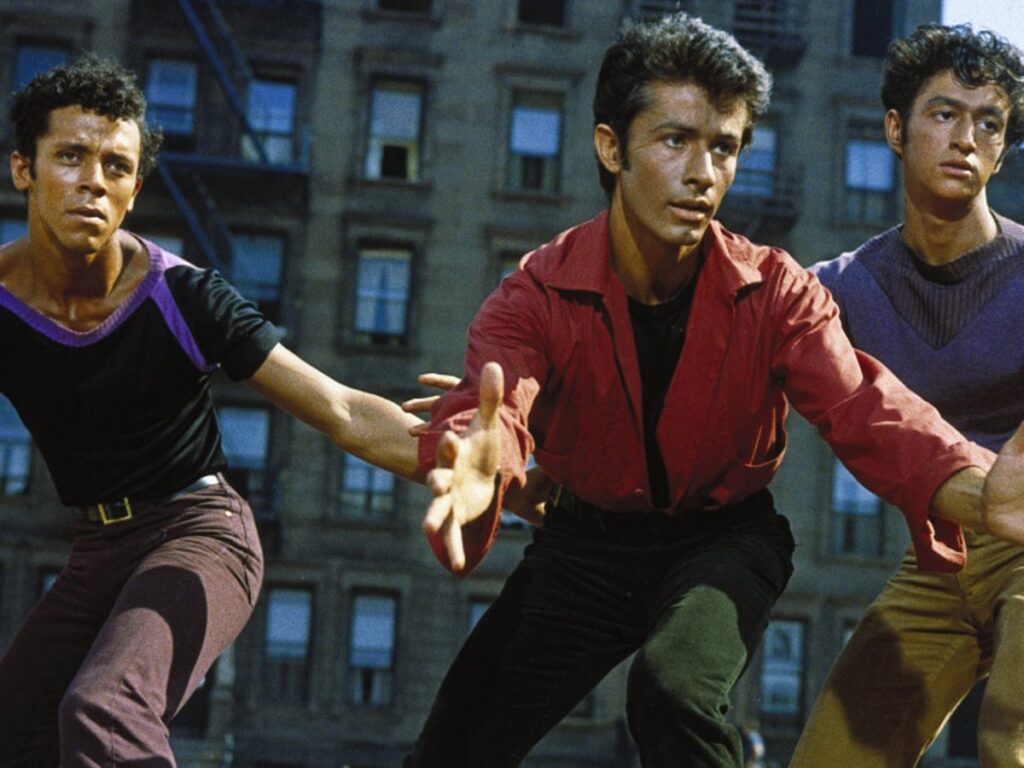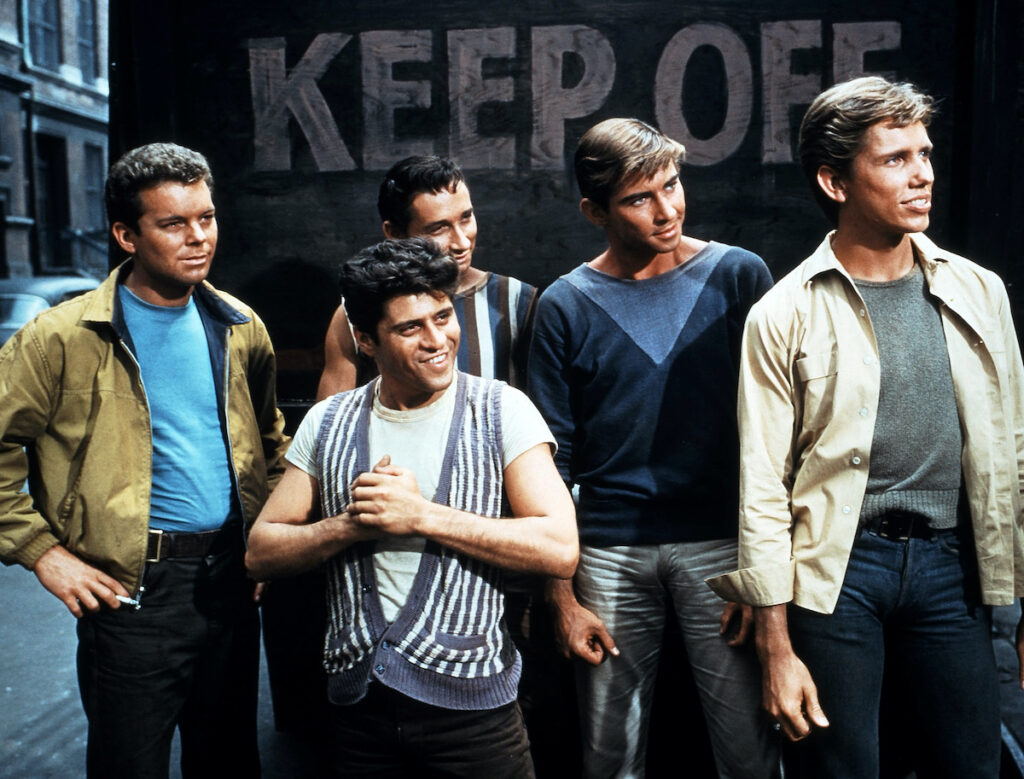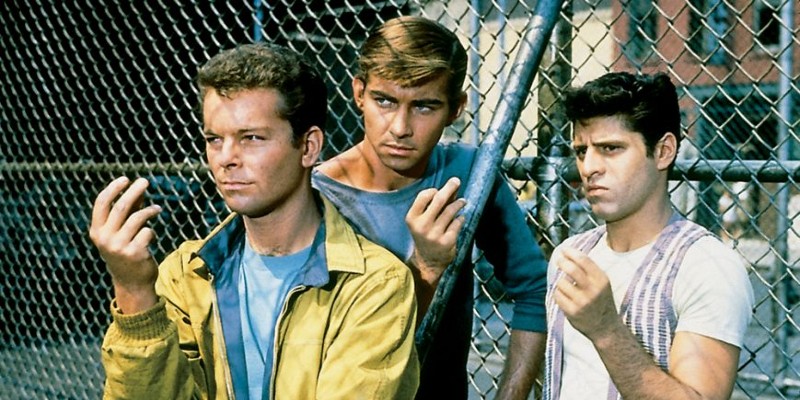No one can claim the movie version of West Side Story hasn’t been given its full and proper due. When it premiered 60 years ago, it opened to huge critical and commercial success, becoming the highest grossing film of 1961 and winning 11 Academy Awards, including Best Picture. A modernized retelling of Romeo and Juliet, in which its star-crossed lovers come from two warring New York City street gangs (the all-white Jets and the Puerto Rican Sharks), it remains one of, if not the greatest of all movie musicals, as well as one of cinema’s most beloved romantic dramas and best, most inventive Shakespeare adaptations.
Currently, the film—co-directed by Jerome Robbins and Robert Wise, written by Ernest Lehman, and adapted from the equally successful and iconic Broadway musical (choreographed and directed by Robbins, with music by Leonard Bernstein, lyrics by Stephen Sondheim, and book by Arthur Laurents)—is enjoying its biggest cultural moment since that barnstorming initial release, thanks to a brand-new remake from Steven Spielberg, the celebration of its diamond anniversary this October and, unfortunately, the recent passing of Sondheim at age 91.
And yet, for all that, it remains undervalued in one regard: as a great American crime epic, one that straddles three different subcategories within the genre: the juvenile delinquent picture, the gangland saga, and, in its bleak and paranoid third act, the classic film noir. The film derives a particular emotive power from that third designation that, like fellow ‘oh, damn, this is actually a noir’ classic It’s a Wonderful Life, ends up shocking many a first-time viewer with its harshness and darkness.
***
Even though it’s a somewhat late entry in the golden age of teenage rebellion films, West Side Story is probably the second most iconic example of the genre, after Nicolas Ray’s noirish 1955 melodrama Rebel Without a Cause (which, you probably don’t need me to tell you, also co-stars Natalie Wood).
Tales of teen rebellion rose to popularity concurrent with the very idea of the ‘teenager’. Prior to the ‘50’s, that had not been a widely accepted designation in America, as young people moved into adulthood pretty much as soon as they were physically able. But thanks to rising prosperity and advances in technology—as well as massive shifts in the collective psyche, no doubt—following World War II, teens were given greater amounts of freedom, as well as a disposable income. Thanks to the advent and massive popularity of rock n’ roll, other sectors of the entertainment industry, including motion pictures, now catered to a youth market that hadn’t previously existed.
With this came a fair amount of backlash and fearmongering, much of which was reflected in movies about the dangers of teenage delinquency. While there are a handful of examples considered classics today—West Side Story and Rebel Without a Cause, along with The Wild One (1954) and Blackboard Jungle (1955)—the majority of these were exploitation pictures catering to and even helping to shape youth culture even as they sounded the alarm over it. Not that this mattered to said youths: despite the heavy moralizing these films espoused over the dangers of popular teen recreations—drag racing, drug use, sexual experimentation, gangs, petty crime—it was all easy enough to ignore in favor of the prurient qualities shown in them.
(For a great example of this, see 1958’s wildly entertaining and utterly ridiculous teenage drug-scare picture High School Confidential, a beatnik predecessor to 21 Jump Street starring Russ Tamblyn three years before he played Jets leader Riff in West Side Story.)
By contrast, films like Rebel Without a Cause and West Side Story, while not absent their own reactionary politics, depicted their characters and stories with more psychological depth and nuance, while also bringing an A-list respectability to the subject matter (this was especially true of WSS, what with its Broadway pedigree).

Coming as it did at the beginning of the ‘60s, as the square conformity of the Eisenhower era began to give way to the more permissive vision of society offered by Kennedy’s Camelot, while at the same time the former’s veneer of stability was crumbling in the face of rising political and cultural turmoil, West Side Story is also franker in its depiction and referencing of charged subject matter than those ‘50’s examples.
This is most evident in the infectious, but darkly fun “Officer Krupke” number, which openly references just about every so-called “social disease” imaginable—including drug use (and drug trafficking), cross dressing and gender bending (to use the terms of the time), prostitution, familial abuse, communism, premarital sex and venereal disease (the basis of its central pun)—all before signing off with a barely veiled exclamation of, “Fuck You!” The song works as a send-up of all those hysterical films about juvenile delinquency, even as the events that are soon to play out in the story will do so in an expectedly violent and tragic manner.
***
More than just a tale of teenage delinquency and youth-in-revolt, West Side Story is a gang drama. In updating its source material (which, as I’ve written about before, lends itself to modern crime interpretations better than just about every Shakespeare play other than Macbeth), the scourge of street gangs proved a ready-made stand-in for the warring dynasties of the original.
When compared the more explicit and realistic gang dramas of both its own day, but especially those of the following decade (including Abel Ferrara’s beautifully gruesome China Girl [1987], which is as much a reimagining of WSS as it is Romeo and Juliet) and into the 1990s—when stories about urban youth gangs, such as Colors, Boyz n the Hood, Menace II Society, American Me, Blood In Blood Out and others—reached their zenith in terms of cultural importance and mainstream popularity (thanks largely to the parallel ascendance of rap music), West Side Story may seem light and fluffy, what with all the singing and dancing, and it’s ostentatious set dressing and costuming.
However, the film actually paints a far more complex picture of gang culture than at first it may seem. The movie makes no bones about the smallness of its central drama’s stakes: none of The Jets or The Sharks are hardened criminals (if they engage in any actual organized crime, such as dope pushing or theft, it’s never explicitly stated), they’re only a collection of impoverished kids—literal children, as more than one character calls them—fighting on and over a playground. And yet, the psychology at work shows how partisan conflicts over that most precious of commodities— “turf”—inevitably leads to war, which irrevocably ends in grown-up bloodshed.

West Side Story is, in keeping with its Shakespearean roots, a tragedy. But more than the death of lovelorn hero Tony (Richard Beymer) at the film’s climax, the real tragedy is that The Jets and The Sharks don’t realize how much they’re meant to be together from the beginning. In all their early interactions, it’s clear that, despite the territorial disputes and deep-seated racial animus running between them, they seem to actually like one another, constantly making each other laugh and taking up one another’s side when squaring off against their mutual enemy, the cops, as represented by the racist Lieutenant Schrank (Simon Oakland), who continually busts The Jets but is more than happy to back them if it means clearing his beat of “the spics”, and the brutish Officer Krupke.
There is a class consciousness within this film as strong as any contained in those grittier examples, even if it is punctuated by 30-something actors dressed like teenagers (or decked in brown face) doing pirouettes and jazz hands.
***
Within this larger social drama about urban street violence and wayward youth is another type of gangster story, one that feels closer to adult dramas like The Godfather or Miller’s Crossing, even though it tends to get overlooked in favor of the other plot threads.
Ask most people who the hero of West Side Story is and they’ll likely say Maria (Natalie Wood), along with Tony or even Anita (although in the latter’s case, that’s mostly due to how good Rita Moreno is in the role). But if you ask me, the real hero of the film isn’t any of the four leads, but rather Ice, The Jet’s go-to pugilist who, over the course of the film, rises to the role of leader.
As played by original cast member Tucker Smith, Ice was a character created specifically for the movie. He doesn’t make much of an impression during the first half, mostly standing around in the background coolly brooding while the Jets goof off, argue and act tough. Even when he’s chosen as the group’s “best man” and slotted into a one-on-one fight against Sharks’ leader Bernardo (George Chikaris) for control of the neighborhood, he still seems like a third stringer, especially when compared to Tony and Riff.

It’s only after Bernardo and Riff are killed in the rumble and The Jets find themselves on the verge of collapse that he moves to the fore, corralling his gang in a parking garage and getting them to check their tempers by way of the staccato number “Cool”.
Immediately following this, he takes the reins, and it quickly becomes apparent why Riff had chosen him as their proxy earlier. Not only does he remain calm, collected and sly in the aftermath of the rumble, he’s also revealed to be the moral center of the gang, particularly in his encouragement of tomboy hanger-on Anybodys (Susan Oakes, in one of the few sympathetic portrayals of a queer, and possibly even trans, character from the time), who up to that point had been a target of abuse from the others. It’s equally important that as soon as Ice takes leave of the group—bravely risking his life and freedom to search for an in-the-wind Tony—they devolve into their most savage selves, nearly raping Anita and setting in motion the misunderstanding that results in Tony’s murder.
When you rewatch the film, it becomes clear that Ice is actually a key character from the get, subtly advising Riff’s decision making throughout the entire first half (like Tony, he’s always trying to keep the violence from escalating beyond fisticuffs). In this, he operates as something of a consiglieri, the man behind the man, not unlike Toms Hagen and Reagan from the aforementioned Godfather and Miller’s Crossing, respectively.
While it’s a good thing United Artists never tried to cash in on the success of West Side Story with any sequels or spin-offs, a part of me wishes we’d gotten to see the further adventures of Ice as he climbs up the criminal ladder.
***
During the third act, the entire tone of West Side Story shifts. Gone are the bright colors, rambunctious energy and swooning romance that have up-to-then defined the film. In their place, we are made witness to a long dark night of the hoodlum soul, one cast in the blue and crimson colors of the police siren, and the deep black void of the city streets. It’s here that the film moves fully into noir territory.
Film noir was a term only retroactively applied to various crime dramas, thrillers and melodramas of the ‘40s and early ‘50s, and generally relegated to those shot in black and white. However, there are a handful of technicolor noirs—Leave Her to Heaven, Niagara, Vertigo—amongst which WSS should count. The scenes of Ice fleeing through the empty streets, his back against a brick wall plastered over with a huge fly poster bearing the judgmental visage of a city father who might as well be a God, or of Tony quietly stalking those same streets, blood on his hands and vengeance on his mind, on his way to meet his doom, are as noir as noir gets.

Credit here must go to co-director Robert Wise. When production began on West Side Story, producers were keen to bring along the show’s original director, Jerome Robbins. But they were also wary, since he’d only directed for the stage. Their solution was to let Robbins direct the song and dance numbers, while tapping Wise—a seasoned and dependable filmmaker who had experience making gritty crime stories—to shoot the dramatic scenes. This proved a smart choice, as Robbins ended up going way over schedule, which eventually led to him being fired. Wise managed to shoot the remainder of the dance scenes himself (with lots of help from Robbins’ assistants), although when the picture was completed, he insisted that Robbins be given co-directing credit.
Although today he’s best remembered for the two musicals he helmed, WSS and The Sound of Music (1965), Wise was an electric genre hopper, working in science fiction (The Day the Earth Stood, Star Trek: The Motion Picture), horror (The Haunting, The Body Snatcher, Curse of the Cat People), and, most importantly, hardboiled crime.
He would imbue WSS with elements from the previous crime films he made: the self-destructive pull of love and sex from 1947’s Born to Kill, urban life as a rigged game from which there is no escape from 1949’s The Set-Up (note the compositional similarity between the final scenes of that film and WSS), and the mutually assured destruction begot by America’s unique brand of race hate from 1959’s Odds Against Tomorrow.
Across all these films, but especially in West Side Story, Wise casts the American experience in the fatalistic narrative of noir. To quote from its greatest musical number and set-piece, America is a land where “You are free, and you have pride/Long as you stay on your own side.” Try to cross that line and you get laid out in the street, all of your hopes and dreams bleeding out into the cracks of the broken concrete.
In America, indeed.

















